I can change sounds to make new words
RF.K.2e I can change sounds to make new words.
I “Tin” Make Words
Place magnetic letters that can be used to make a word family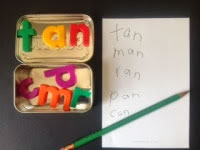 in an empty mint tin. For example: o, p, t, m, h, c, b. Add a list of words that can be made from the letters in the tin. (hop, mop, top, cop, pop, bop) Children reproduce the words on the lid of the tin and read them. You could also ask them to write the words.
in an empty mint tin. For example: o, p, t, m, h, c, b. Add a list of words that can be made from the letters in the tin. (hop, mop, top, cop, pop, bop) Children reproduce the words on the lid of the tin and read them. You could also ask them to write the words.
Phonics Fingers
You will need 3 pairs of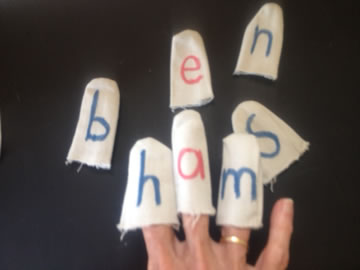 white cloth garden gloves for this project. Cut the fingers off the gloves. Write a letter on each finger with markers. (Write consonants in blue and vowels in red.) Children insert glove fingers on their own fingers to make CVC words. Have them substitute letters to make new words.
white cloth garden gloves for this project. Cut the fingers off the gloves. Write a letter on each finger with markers. (Write consonants in blue and vowels in red.) Children insert glove fingers on their own fingers to make CVC words. Have them substitute letters to make new words.
Donut Words
Cut donut shapes out of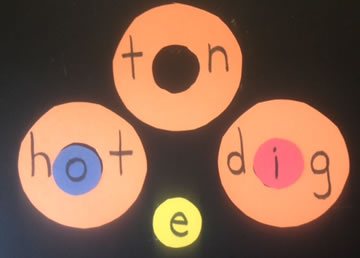 construction paper. Write consonants on either side of the donut hole. Write vowels on small circles. Children place the donut “holes” between the consonants and blend the sounds.
construction paper. Write consonants on either side of the donut hole. Write vowels on small circles. Children place the donut “holes” between the consonants and blend the sounds.
RF.K.3 I can use letters and sounds to make new words.
Letter Tin
Place magnetic letters  inside a cookie tin. On the inside cover make three lines with a permanent marker. Have the children take out the letters and place them around the lid. Give children a list of CVC words to make and read.
inside a cookie tin. On the inside cover make three lines with a permanent marker. Have the children take out the letters and place them around the lid. Give children a list of CVC words to make and read.
Unifix Cubes
Place dot stickers on unifix  cubes. Write letters on the dots. Children can use these for constructing words.
cubes. Write letters on the dots. Children can use these for constructing words.
*Let children play this game with a friend. One child builds a word and the other friend must then read it.
Alphabet Soup
Place magnetic letters in a bowl. Give children a large soup spoon to scoop out some letters. Can they make a word with the letters? Have them write the words that they make.
in a bowl. Give children a large soup spoon to scoop out some letters. Can they make a word with the letters? Have them write the words that they make.
RF.K.3a I can make the sound of each letter.
Name Acrostic
Children write the 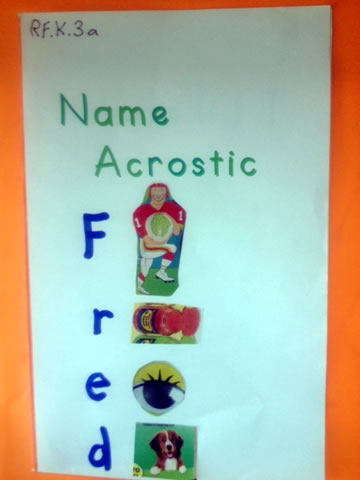 letters in their name down the left side of a sheet of paper. Ask them to cut out words or pictures that begin with each letter and glue them next to the letter.
letters in their name down the left side of a sheet of paper. Ask them to cut out words or pictures that begin with each letter and glue them next to the letter.
Poke and Peek
Cut out a simple 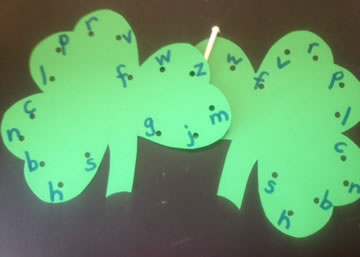 shape (seasonal, animal, toy, etc.) from heavy paper. Punch holes around the outside. Write letters around each of the holes. One child takes the golf tee and inserts it in each hole as they make the sound for the letter. A friend sits facing them and tries to name the letter.
shape (seasonal, animal, toy, etc.) from heavy paper. Punch holes around the outside. Write letters around each of the holes. One child takes the golf tee and inserts it in each hole as they make the sound for the letter. A friend sits facing them and tries to name the letter.
Sports Flip
Cut out footballs, baseballs, or other sports objects on a folded sheet of paper. 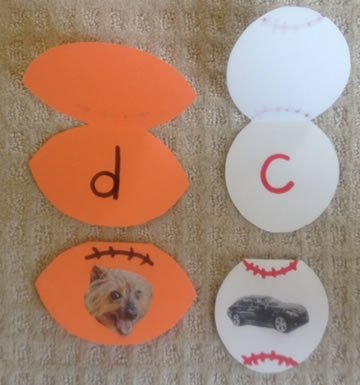 Put a picture on the front. Open and write the letter that the object begins with. Children identify the sound they hear at the beginning of each picture and the open to self-check.
Put a picture on the front. Open and write the letter that the object begins with. Children identify the sound they hear at the beginning of each picture and the open to self-check.
Play Dough Phonics
Let children use play dough to make objects that begin with different letter sounds.
*Use play dough to make two words that rhyme.
RF.K.3b I can match long and short vowel sounds with common spellings.
Magic E Wand
Cut out a paper star and write “e” on it. Staple to a straw. Make a list of CVC words. Have children add the “e” to the end and read the new word.
and write “e” on it. Staple to a straw. Make a list of CVC words. Have children add the “e” to the end and read the new word.
T-Chart
Make a T-chart and write “short vowel” on one side and “long vowel” on the other side. Use a picture cue representing each sound. Glue pictures to index cards of objects with that short and long vowel sound. Also, write words on index cards with both sounds. Children sort the pictures and then sort the words. How are the words with the long vowel the same?
RF.K.3c I can read my sight words.
In the News
Give children a section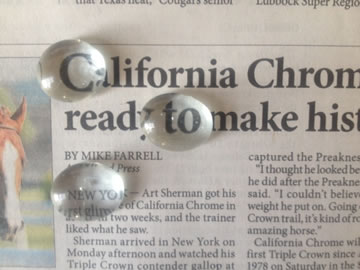 of the newspaper and highlighters. How many letters can they find that they can read? Ask them to write the words on a sheet of paper.
of the newspaper and highlighters. How many letters can they find that they can read? Ask them to write the words on a sheet of paper.
*Children can also identify words with glass pebbles.
String and Read
Place a list of words in a box along with pipe cleaners and letter beads. Children string the beads on the pipe cleaner to spell words.
Roll and Write
Make a graph with 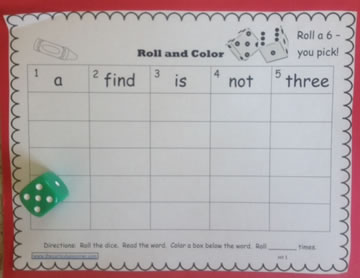 five sections going across and six going down. Number the sections in the top row 1-5 and then write a high frequency word in each section. Children roll a die. They find that number at the top of their frame and then write that word under it. They continue rolling the die and writing words as long as time permits.
five sections going across and six going down. Number the sections in the top row 1-5 and then write a high frequency word in each section. Children roll a die. They find that number at the top of their frame and then write that word under it. They continue rolling the die and writing words as long as time permits.
Four Square Writing
Show children how to fold 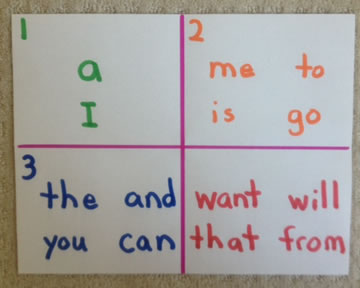 a sheet of paper into fourths. Have them trace over the creased lines to make four squares. Number the sections “1,” “2,” “3,” “4.” Ask children to write one letter words in the section numbered “l.” Write 2 letter words in the second section, 3 letter words in the third section, and 4 letter words in the fourth section.
a sheet of paper into fourths. Have them trace over the creased lines to make four squares. Number the sections “1,” “2,” “3,” “4.” Ask children to write one letter words in the section numbered “l.” Write 2 letter words in the second section, 3 letter words in the third section, and 4 letter words in the fourth section.
Bookmark
Make a bookmark  from a 2” x 8 ½” piece of construction paper. Give children old newspapers and magazines and ask them to out words they can read and glue them to the bookmark.
from a 2” x 8 ½” piece of construction paper. Give children old newspapers and magazines and ask them to out words they can read and glue them to the bookmark.
Word Necklace
Cut a sheet of paper in half. Fold into eighths and cut on the creased lines.  Staple to make a small book. Hole punch in the corner and tie on a piece of string. Children walk around the classroom and write words they can read.
Staple to make a small book. Hole punch in the corner and tie on a piece of string. Children walk around the classroom and write words they can read.
*Use this necklace book for color words, shapes, adjectives, etc.
Rainbow Writing
Make “rainbow words” by tracing around each word with different colors of crayons.
Secret Code
On a sentence strip write the letters of the alphabet. Under each letter write numbers from 1-26. Write numbers for the sight words you are working on. Children find the number and write the corresponding letter to decode the words.
numbers from 1-26. Write numbers for the sight words you are working on. Children find the number and write the corresponding letter to decode the words.
Word Search
Prepare a list of words found in the classroom and run off. Children walk around the room searching for the words on the list. They can cross through the words as they find them.
Partner Read the Room
One child is the “student” and wears an empty pair of glasses. The other child is the “teacher” and holds a pointer. As they walk around the room the teacher points to words and the student reads them. After ten words they switch places.
Note! Whisper voices only for this activity!
Phrase Phone
You can recycle an old cell phone for this center. Write fluency phrases (or words) on jumbo craft sticks and place in a plastic cup. Children remove sticks and read the phrases on the phone.
RF.K.3d I can tell similar words apart by the sounds.
Flip Book
Fold over 1 ½” on the end of index cards. Open and write a CVC word. Fold over the top flap and write a consonant that will make a new word. Children open and close the flap to read the words.
Vowel Stars
This idea is from fcrr.org. Cut out five pointed stars and write a different vowel in each point. Write C_C in the middle. Children insert different vowel sounds and write and read the words.
RF.K.4 I can read books on my own.
Mirror Reading
Let children read books to themselves in a mirror.
Pick a Pal
Place a basket of books and small stuffed animals or puppets in the center. Children choose a book and read it to a toy.
Read to a Star
Frame photographs of sports figures, politicians, or musicians that children are familiar with in the classroom library. Children choose a book and then read it to their favorite star.
Book Bucks
Children make wallets out of construction paper. (Place a sheet of construction paper lengthwise on the table and fold up the bottom 1” below the top. Fold in half. Glue the two sides.) Cut “book bucks” out of 2” x 4” green paper. Every time children read a book they can write the title on a “book buck” and save it in their wallets.
out of construction paper. (Place a sheet of construction paper lengthwise on the table and fold up the bottom 1” below the top. Fold in half. Glue the two sides.) Cut “book bucks” out of 2” x 4” green paper. Every time children read a book they can write the title on a “book buck” and save it in their wallets.
Hand Phone
Phonics phones are perfect for children to hear themselves read. You can purchase these or make one out of PVC pipe. However, if you don’t have one, you can teach the children how to make a phone with their hand. If they cup one hand around their ear and the other hand around their mouth they can hear themselves read.
First Page
 in an empty mint tin. For example: o, p, t, m, h, c, b. Add a list of words that can be made from the letters in the tin. (hop, mop, top, cop, pop, bop) Children reproduce the words on the lid of the tin and read them. You could also ask them to write the words.
in an empty mint tin. For example: o, p, t, m, h, c, b. Add a list of words that can be made from the letters in the tin. (hop, mop, top, cop, pop, bop) Children reproduce the words on the lid of the tin and read them. You could also ask them to write the words. white cloth garden gloves for this project. Cut the fingers off the gloves. Write a letter on each finger with markers. (Write consonants in blue and vowels in red.) Children insert glove fingers on their own fingers to make CVC words. Have them substitute letters to make new words.
white cloth garden gloves for this project. Cut the fingers off the gloves. Write a letter on each finger with markers. (Write consonants in blue and vowels in red.) Children insert glove fingers on their own fingers to make CVC words. Have them substitute letters to make new words.  construction paper. Write consonants on either side of the donut hole. Write vowels on small circles. Children place the donut “holes” between the consonants and blend the sounds.
construction paper. Write consonants on either side of the donut hole. Write vowels on small circles. Children place the donut “holes” between the consonants and blend the sounds. inside a cookie tin. On the inside cover make three lines with a permanent marker. Have the children take out the letters and place them around the lid. Give children a list of CVC words to make and read.
inside a cookie tin. On the inside cover make three lines with a permanent marker. Have the children take out the letters and place them around the lid. Give children a list of CVC words to make and read. cubes. Write letters on the dots. Children can use these for constructing words.
cubes. Write letters on the dots. Children can use these for constructing words. in a bowl. Give children a large soup spoon to scoop out some letters. Can they make a word with the letters? Have them write the words that they make.
in a bowl. Give children a large soup spoon to scoop out some letters. Can they make a word with the letters? Have them write the words that they make. letters in their name down the left side of a sheet of paper. Ask them to cut out words or pictures that begin with each letter and glue them next to the letter.
letters in their name down the left side of a sheet of paper. Ask them to cut out words or pictures that begin with each letter and glue them next to the letter. shape (seasonal, animal, toy, etc.) from heavy paper. Punch holes around the outside. Write letters around each of the holes. One child takes the golf tee and inserts it in each hole as they make the sound for the letter. A friend sits facing them and tries to name the letter.
shape (seasonal, animal, toy, etc.) from heavy paper. Punch holes around the outside. Write letters around each of the holes. One child takes the golf tee and inserts it in each hole as they make the sound for the letter. A friend sits facing them and tries to name the letter. Put a picture on the front. Open and write the letter that the object begins with. Children identify the sound they hear at the beginning of each picture and the open to self-check.
Put a picture on the front. Open and write the letter that the object begins with. Children identify the sound they hear at the beginning of each picture and the open to self-check.  and write “e” on it. Staple to a straw. Make a list of CVC words. Have children add the “e” to the end and read the new word.
and write “e” on it. Staple to a straw. Make a list of CVC words. Have children add the “e” to the end and read the new word.  of the newspaper and highlighters. How many letters can they find that they can read? Ask them to write the words on a sheet of paper.
of the newspaper and highlighters. How many letters can they find that they can read? Ask them to write the words on a sheet of paper. five sections going across and six going down. Number the sections in the top row 1-5 and then write a high frequency word in each section. Children roll a die. They find that number at the top of their frame and then write that word under it. They continue rolling the die and writing words as long as time permits.
five sections going across and six going down. Number the sections in the top row 1-5 and then write a high frequency word in each section. Children roll a die. They find that number at the top of their frame and then write that word under it. They continue rolling the die and writing words as long as time permits. a sheet of paper into fourths. Have them trace over the creased lines to make four squares. Number the sections “1,” “2,” “3,” “4.” Ask children to write one letter words in the section numbered “l.” Write 2 letter words in the second section, 3 letter words in the third section, and 4 letter words in the fourth section.
a sheet of paper into fourths. Have them trace over the creased lines to make four squares. Number the sections “1,” “2,” “3,” “4.” Ask children to write one letter words in the section numbered “l.” Write 2 letter words in the second section, 3 letter words in the third section, and 4 letter words in the fourth section. from a 2” x 8 ½” piece of construction paper. Give children old newspapers and magazines and ask them to out words they can read and glue them to the bookmark.
from a 2” x 8 ½” piece of construction paper. Give children old newspapers and magazines and ask them to out words they can read and glue them to the bookmark. Staple to make a small book. Hole punch in the corner and tie on a piece of string. Children walk around the classroom and write words they can read.
Staple to make a small book. Hole punch in the corner and tie on a piece of string. Children walk around the classroom and write words they can read.
 numbers from 1-26. Write numbers for the sight words you are working on. Children find the number and write the corresponding letter to decode the words.
numbers from 1-26. Write numbers for the sight words you are working on. Children find the number and write the corresponding letter to decode the words. out of construction paper. (Place a sheet of construction paper lengthwise on the table and fold up the bottom 1” below the top. Fold in half. Glue the two sides.) Cut “book bucks” out of 2” x 4” green paper. Every time children read a book they can write the title on a “book buck” and save it in their wallets.
out of construction paper. (Place a sheet of construction paper lengthwise on the table and fold up the bottom 1” below the top. Fold in half. Glue the two sides.) Cut “book bucks” out of 2” x 4” green paper. Every time children read a book they can write the title on a “book buck” and save it in their wallets.